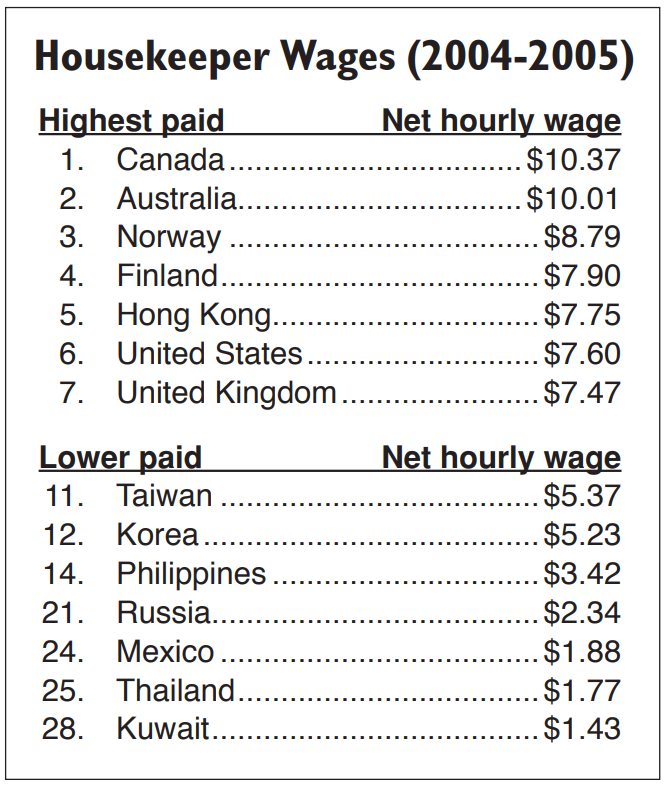Have you ever wondered about the wages earned by hotel workers in other countries?
A website at http://www.worldsalaries. org/ shows you the salaries earned by different occupations in countries around the world.
The comparisons are based on the money it would take to have a similar standard of living. This is called purchasing power parity. There are also comparisons for teachers, doctors, and other occupations.
The data at right is from 2004 or 2005 and are the average hourly wage after deducting taxes and social security. Canadian and Australian housekeepers earn the highest wages. The United States ranks around #6 as these are average wages and most U.S. hotels are not unionized. Unionized housekeepers would earn much more. The lower paid are a few selected countries and show some of the rankings between 11 and 28.



HC&S biofuel partnership—continued from page 4
2,000 gallons of ethanol can be made from one acre of sorghum.
One promising technology is producing ethanol from the cellulose which makes up most of any plants. Cellulosic ethanol is produced by using enzymes and other methods to convert the entire plant into sugar and then fermenting the sugar into ethanol. Cellulosic ethanol can use any fast growing plant, such as sorghum or prairie grass, and has the potential of producing ethanol far cheaper than using corn. Studies indicate that many cellulose plants could be grown on marginal land, require less water and fertilizer, and could produce as much as five times more energy as ethanol than it takes to grow and process the plants.
The money from the Navy grant will focus on making cellulosic ethanol production more efficient and cost-competitive with corn-based ethanol and to build large-scale capacity which can produce millions of gallons of ethanol. The Navy hopes to reduce its reliance on petroleumbased fossil fuels, much of which is imported, by using locally produced biofuel (fuel produced from plants) for half of its shore-side energy needs by 2020.
HC&S is an ideal place to test plants for their potential as biofuel, as the warm climate in Hawaii allows two or more crops to be grown in one year, there is plenty of land, there is a mill that can process the ethanol, and there is already a skilled workforce to cultivate the plants. HC&S workers also have the experience and know-how in trimming costs and squeezing the highest efficiency out of their sugar making.
Record high sugar prices—continued from page 4
The world’s largest sugar exporter is Brazil. Heavy rains are expected to reduce the 2011 Brazilian crop, and the country uses more than half of their sugar to produce ethanol to fuel their automobiles which can burn either blended gasoline or pure ethanol. When oil prices are high, more Brazilian sugar goes to produce ethanol and less sugar is sold on the world market.
India is the second largest exporter of sugar but is also a large consumer of sugar. Several years of poor harvests have forced the country to limit exports, and the country’s sugar stockpiles are four million tons short of its preferred reserve of ten million tons.
The third largest exporter of sugar, Australia, is expected to lose over 20 percent and more of its sugar production in 2011 because it’s sugar crop was badly damaged by heavy rain and floods in December and January. Damage to the cane plants and fields of the main sugar producing area in Queensland may reduce Australian sugar exports for the next two to three years.
The world demand for sugar is growing faster than the supply of sugar, which is driving the price of sugar to historic highs. Had G&R waited until 2010 to bring in their last harvest, they might still be in the sugar business.
Dictionary of alternate energy words
GREENHOUSE GASES such as carbon dioxide increase global warming by trapping heat in the atmosphere. Global warming is dangerous because it is changing the world’s climate, weather patterns, and rises the level of the sea. This can lead to crop failures, collapse of fisheries, and flooding of coastal cities where most of the world’s people now live. If the earth becomes too warm, the process can not be stopped which could threaten all life on earth. This has led the United Nations to seek agreements among the world’s nations to limit carbon emissions.
FOSSIL FUELS such as oil and coal are produced after millions of years of decomposing plant or animal materials. Burning fossil fuels to produce electricity or to power automobiles and trucks is a major source of carbon dioxide, the most serious greenhouse gas. The supply of fossil fuels is limited and now require more expensive and risky methods to retrieve. Oil companies are drilling more deep water wells which can result in environmental disasters such as the massive British Petroleum (BP) oil spill in the Gulf of Mexico.
RENEWABLE ENERGY comes from sources that are unlimited such as sunlight, wind, water, ocean tides, and geothermal heat. Solar water heating, solar electricity, wind turbines, hydroelectric dams, and geothermal now generate enough power to meet about 20 percent of the world’s energy needs. These are clean energy sources because they produce no carbon dioxide and have almost no negative impact on the environment. Hawaii has the potential to generate most of our energy needs from renewable sources.
BIOFUEL is the use of plants to supply energy, primarily by converting plant sugars or fibers into ethanol to mix with gasoline or by converting plant oil or waste cooking oil into diesel fuel. The corn-to-ethanol methods used in the United States produces a very small energy benefit—it takes almost as much energy to cultivate and convert the corn into ethanol as the energy content of the ethanol itself. Some of the better plants for biofuel include sweet sorghum and jatropha seeds to produce oil which can be used as diesel fuel.

